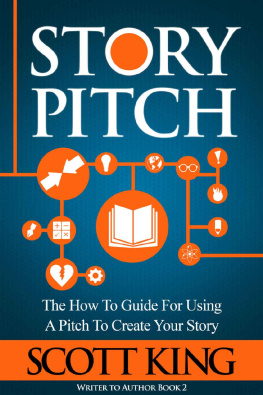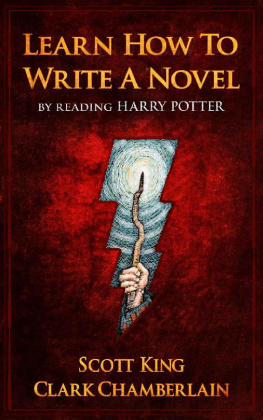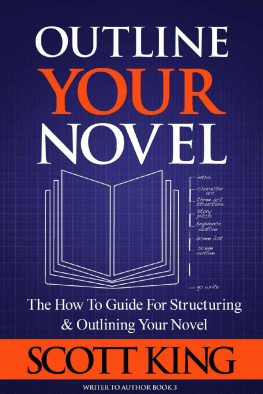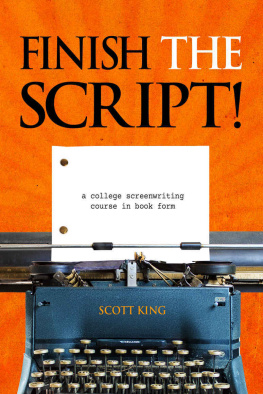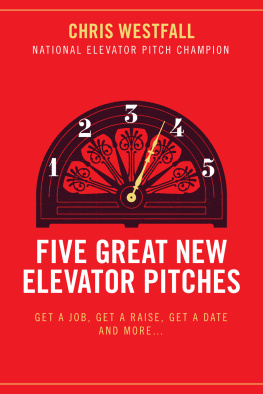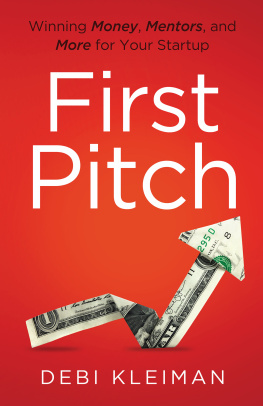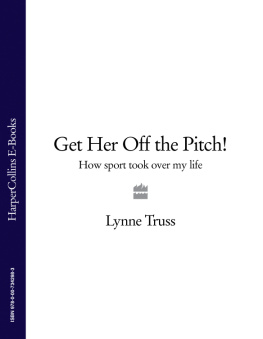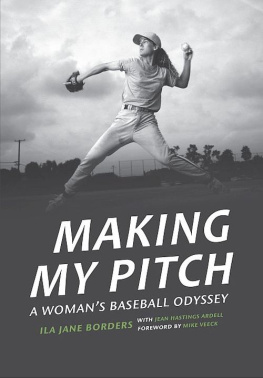W ord up? Im Scott King and this is the introduction. Thats good cause I like introductions. Its where I get to be me and you get to be you. Ill say something odd like, It only rains hot dogs on the coldest nights of summer, and you decide whether Im too weird for you to want to keep reading. You should keep reading though, because I have a lot of ninja craft stuff in this book .
What you need to know about me is fairly simple. I find poop jokes funny. I pay off my ridiculous amount of college loans through board game photography and writing. I enjoy teaching and, until we moved to coastal Texas to follow my wifes career, I was a college professor at a four-year university. In life, I want to make a living telling stories that connect and move people. I also want to help people grow. I try to do that with my fiction in the themes and stories I tell, and I try to do that with my non-fiction by offering whatever tips I can to help people improve their craft .
Story Pitch isnt my first book on writing. I have two others: The 5 day Novel and Finish the Script! The most popular chapter in Finish the Script! is about writing an elevator pitch, and one of the most asked about chapters in The 5 Day Novel deals with using a pitch as a tool for pre-writing and rewriting. Thats how the concept of a Story Pitch was born. I decided to merge what I know about pitching and using pitches as tools, into a system that writers can use to jump-start their stories .
This book is geared toward authors, but because of my screenwriting and comics background, I designed Story Pitch to be useful to anyone who creates fiction. The core of a Story Pitch is about finding the story you want to tell and whether you are writing novels, graphic novels, short stories, screenplays, or whatever, finding your story is important .
Do I expect using a Story Pitch will change your life and help you break into the top 100 on Amazon? No. Spoiler alert: there is no magic code or ingredient to solve all your writer problems. But using a Story Pitch can help make the process a bit easier and, with writing being as hard as it is, why not make it a bit easier on yourself ?
The final thing you should know about me is one of my main teaching philosophies: the only wrong way to write is to not write. What works for one person creatively might not work for someone else and no matter what rules people like me tell you to use, the only real rule is that if you want to be a writer you must write. The only right way to write is the way that allows you to write your story. Fingers crossed, a Story Pitch will help you do that .
A pitch is a description of a story that a person uses to sell it. In Hollywood, it might be that a writer is pitching a screenplay to producers, hoping they buy it. In traditional publishing, it might be an author pitching a novel to an agent who would then pitch it to one of the big six publishers .
Anytime you meet someone and they ask you about what youve written, whether its a novella, short story, or full-blown three-hundred-thousand-word epic, what you say back to them is a pitch .
Pitching is part of a writers world. No matter how much you might hate giving one, you cant escape it. Book blurbs that appear on the back of a novel or on a retailer website are also pitches. They are carefully crafted descriptions meant to sell the story to a potential reader .
You can use a Story Pitch to create all the pitches I described above, but the main goal of a Story Pitch isnt to sell the idea of your story to someone else. A Story Pitch is meant to be a tool you can use when pre-writing, writing, and re-writing your story .
Whittled down, a Story Pitch is a synopsis that introduces the key elements of your story, serves as a guide post while writing, and creates enough interest to hook the listener so theyll want more .
Before writing a Story Pitch, you need to understand what story is. Growing up, I was told that story is rising action with a climax followed by falling action. It also has a beginning, middle, and end. (I have no idea why K-12 teachers always emphasize the beginning, middle, and end thing.) In college, I was told that story is made up of character, setting, plot, and theme. And in graduate school, I was told that story is formed from character arcs and character action. Most of what I was taught was a mix of half-truths and bullcrap .
Ive found there are four basic building blocks of story .
At its core, story is a character that wants something and the conflict that prevents them from getting what they want. Those are the first three .
For example, if I said :
That isnt a story. It is a character taking an action, but without any context that action is meaningless. However, if I said :
- Jamie drank the water, hoping to flush the poison from her mouth .
Thats a story. Its utterly simple and not very deep, but its still a story. You have a character: Jamie. She has a want: getting the poison out of her mouth. And there is conflict: she doesnt know if the water will rinse the poison out .
Lets do one more, but even simpler :
- Mary sat. (Not a story )
- Mary tried to sit. ( Story )
A good gut instinct gauge on the two examples above is to ask if either makes you want to know more. In the first, Mary takes the action of sitting, but thats it. There is no want or conflict. In the second we know Mary wants to sit, because she tried to, and we know there is some form of conflict because she tried to sit, but something stopped her from actually sitting. We dont know what stopped her and already that is more interesting than the first sentence .
Although the core essence of a story is about a character wanting something and something else getting in the way of that want, there is one more thing involved. For example, what happens if a character doesnt get the thing they want? Thats the stakes .
Remember Jamie? If she doesnt get that poison out, she is going to die! Those are some big stakes. What about Mary? If she doesnt get to sit we dont know what will happen. In our current example, she has no stakes. So, lets give her some :
- Mary tried to sit, hoping to hide, but the assassin made eye contact with her .
In our fleshed-out sentence we know that Mary wants to sit because she is hoping to hide from the assassin. If she doesnt sit and is unable to hide, Im guessing things will go very badly for Mary. Assassins are not the kind of people who simply give hugs and walk away. Marys life is on the line! Those are huge stakes! Of course, stakes dont always have to be life and death, but well talk about the various level of stakes later .
These four thingscharacter, want, conflict, and stakesare the basic building blocks of story. Every movie, novel, or piece of fiction can be broken down into those things. They are exactly what I taught in my other writing books, but for a Story Pitch, there needs to be more. In the tech world, they have a thing called the minimum viable product and when built out of those four things thats what a bare bones pitch is. Its still a pitch, but it needs more meat .

